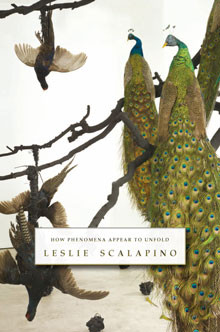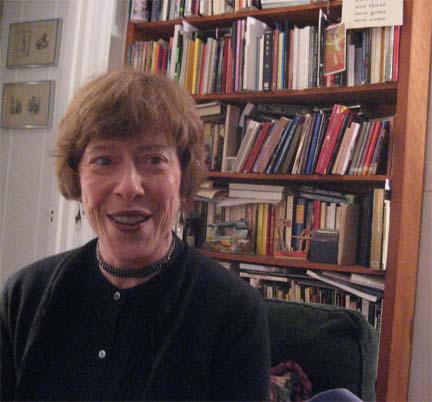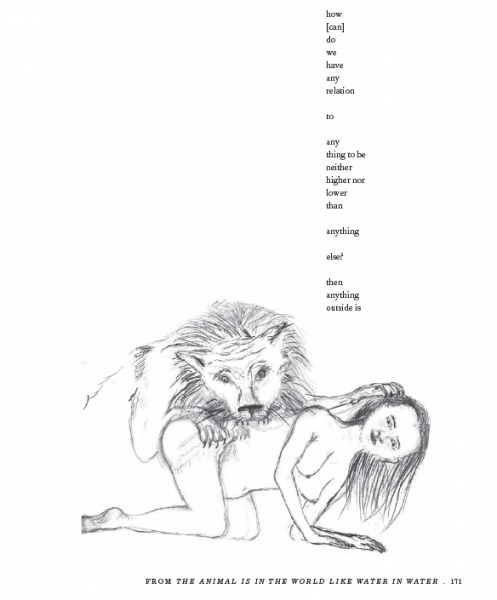
Leslie Scalapino's phenomenal essays

How Phenomena Appear to Unfold
Leslie Scalapino
2011 • 312 pp. • $24.00 • ISBN: 978-1-933959-12-2
Litmus Press | Cover sculpture by Petah Coyne.

Scalapino is always just ahead, inventing the essay anew, as a necessary means for the exploration of consciousness, perception, and meaning in and for language, with full engagement with, and acknowledgement of, the political valences of every poetic act as it falls into, or fails, the social. In the expanded field of L=A=N=G=U=A=G=E, Scalapino's essays are central: a model not just of possibilities but of "landing sites" to use the term of Madeline Gins and Arakawa.
Tracy Grinnell has done a superb job assembling this collection, which Scalapino was working on at the time of her death about a year ago. As always, Scalapino pushes beyond any easy sense of essay. What unfolds here is the startling unexpectedness of thought, articulated in visual and verbal forms that confound genre categories. In this book, Scalapino creates fields for thinking-as-perception, in which the poem emerges from the essay as counterpoint and newly forming foundation. The complex of disparate parts creates working models for a social formalism. Scalapino introduces the terms "seamless antilandscape" to acknowledge that an aversion to traditionl representation does not produce disjunction but rather a syncretic perceptual experience.
This is a touchstone work of pataque(e)rics.
 A central piece in the collection is the collaboration with Kiki Smith, The Animal is in the World Like Water in Water, previously published as an artist's book by Granary Press (a small edition no longer available). This is a key work for Scalapino and it is fortunate to have 12 pages here (see scan on right). In a related essay, Scalapino discusses the serial poetics of this work: "My poem sequence is to reinstate (restate) experiencing in space, the mind/eye making estimations/approximations as concepts that are the same as their being in space: The language makes minute distinctions of its theme and treats these as spatial. For example, the poem-segments posit: society not based on emulation, no individual regarded as higher than another; and posit the individual perceiving in such a way—not having such feelings or behavior of emulation or sense of immanence—though (the segments posit) the individual is aware that others do, different from an animal’s view. These concepts in the world, however, are not submitted to space. (In the world, concepts of feelings—such as peoples in societies feeling social values, having internalized these—are not submitted to this sense of space, of no-hierarchy.)
A central piece in the collection is the collaboration with Kiki Smith, The Animal is in the World Like Water in Water, previously published as an artist's book by Granary Press (a small edition no longer available). This is a key work for Scalapino and it is fortunate to have 12 pages here (see scan on right). In a related essay, Scalapino discusses the serial poetics of this work: "My poem sequence is to reinstate (restate) experiencing in space, the mind/eye making estimations/approximations as concepts that are the same as their being in space: The language makes minute distinctions of its theme and treats these as spatial. For example, the poem-segments posit: society not based on emulation, no individual regarded as higher than another; and posit the individual perceiving in such a way—not having such feelings or behavior of emulation or sense of immanence—though (the segments posit) the individual is aware that others do, different from an animal’s view. These concepts in the world, however, are not submitted to space. (In the world, concepts of feelings—such as peoples in societies feeling social values, having internalized these—are not submitted to this sense of space, of no-hierarchy.)
Here they are submitted to space (of no-hierarchy) to be translated to (a sense of) free space/shape/place.
“Activity is the only community,” Scalapino writes in “The Radical Nature of Experience—on Philip Whalen, Lyn Hejinian, Susan Howe, and Leslie Scalapino.” “The conservative gesture, always a constant (any ordering, institutional and societal) is to view both activity and time per se as a condition of tradition. As such, both time and activity are a “lost mass” at any time. … My focus is on non-hierarchical structure in writing. For example, the implications of time as activity—the future being in the past and present, these times separate and going on simultaneously, equally active (in reference to Whalen’s writing, and similar to Dōgen’s conception of time and being)—suggest a non-hierarchical structure in which all times exist at once. And occur as activity without excluding each other. This is unrelated to social power (it can possibly transcend it) but is related to social intelligibility at some time. Social marginality is a state not producing necessarily, but related to, thought/form as discovery. In Susan Howe’s poetry, “vault line divergence” (dual marginality?) is tracking of observation itself as making a present-time.”
At the Litmus launch for this and other new Litmus books and the new issue of Aufgabe, I read the beginning of Leslie's note for Jerry Estrin:
Man who’s young so it seems the rest of us don’t die now oddly. There’s no effect to being alive. Why create needless pain by living. At all. Or by dying, for that matter. I mean why is there creating pain by living in the first place or by dying, at all? We have to.
So not living in the first place, yet we live here.
We don’t have this pain not living in the first place. Yet here. I see that.I’m going to have to do that.
Why does anything dream in that case? If we’re not living in the first place? That was first.
So there’s some activity but that isn’t living. That’s what it is. Some activity before occurs. That’s what that is.
In the blue boil the officer furious is a gazelle.
He flies, the slender arms out. He’s paying attention to the dark air.
Floating is the worm as such. The night produces it. That is there.
No ordinary life is enough for what we’re having.
I want more but it’s there.
I love life so much I want only to live. That’s wrong as a goal. I don’t know why.
The oval opens the black teeth between the lips. A fire storm in the city took her family with hundreds of thousands of others during the war.
Scalapino at PennSound
Scalapino at EPC
Photo: Charles Bernstein